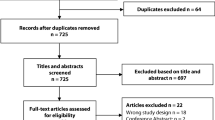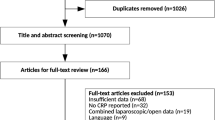Abstract
Purpose
Infectious complications (ICs) after mesh-reinforced ventral hernioplasty often lead to prolonged and complicated hospitalizations. As early diagnosis and management can mitigate complications, early prediction is important. Our aim was to determine whether postoperative blood tests are valuable predictors of IC.
Methods
We retrospectively analyzed 373 patients who underwent conventional ventral hernioplasty with mesh augmentation between 2008 and 2011. The clinical outcome was correlated with postoperative serum C-reactive protein (CRP) and white blood cell counts (WBC) and assessed by area under the curve (AUC) analysis of the receiver operating characteristics curve.
Results
ICs occurred in 51 (13.7%) patients, who required further management. Among these, 48 patients developed a procedure-related complication, the most frequent being surgical site infection (n = 44). The infections appeared after a median postoperative delay of 12 days. Serum CRP was superior to WBC in the prediction of a complicated course. A maximum CRP < 105 mg/L on postoperative day (POD) 2 or 3 had the highest negative predictive value (NPV; 100%) in ruling out ICs [positive predictive value (PPV) 29%; sensitivity 100%; specificity 55%]. The PPV for occurrence of IC improved each day after surgery, reaching up to 46% on POD 5 or 6 for a CRP cut-off of 63.2 mg/L (NPV 93%; sensitivity 69%; specificity 83%). The AUC was 0.80 at both time points.
Conclusions
Our results indicate that postoperative serum CRP allows for early prediction of the postoperative course. Low CRP during the initial PODs is associated with lower risk of ICs. Higher levels on POD 5 or 6 behoove close surveillance.
Similar content being viewed by others
References
Adamina M, Kehlet H, Tomlinson GA, Senagore AJ, Delaney CP (2011) Enhanced recovery pathways optimize health outcomes and resource utilization: a meta-analysis of randomized controlled trials in colorectal surgery. Surgery 149(6):830–840. https://doi.org/10.1016/j.surg.2010.11.003
Kokotovic D, Bisgaard T, Helgstrand F (2016) Long-term recurrence and complications associated with elective incisional hernia repair. JAMA 316(15):1575–1582. https://doi.org/10.1001/jama.2016.15217
Petro CC, Posielski NM, Raigani S, Criss CN, Orenstein SB, Novitsky YW (2015) Risk factors for wound morbidity after open retromuscular (sublay) hernia repair. Surgery 158(6):1658–1668. https://doi.org/10.1016/j.surg.2015.05.003
Forbes SS, Eskicioglu C, McLeod RS, Okrainec A (2009) Meta-analysis of randomized controlled trials comparing open and laparoscopic ventral and incisional hernia repair with mesh. Br J Surg 96(8):851–858. https://doi.org/10.1002/bjs.6668
Berrevoet F, Vanlander A, Sainz-Barriga M, Rogiers X, Troisi R (2013) Infected large pore meshes may be salvaged by topical negative pressure therapy. Hernia J Hernias Abdom Wall Surg 17(1):67–73. https://doi.org/10.1007/s10029-012-0969-3
Wade A, Plymale MA, Davenport DL, Johnson SE, Madabhushi VV, Mastoroudis E, Tancula C, Roth JS (2018) Predictors of outpatient resource utilization following ventral and incisional hernia repair. Surg Endosc 32(4):1695–1700. https://doi.org/10.1007/s00464-017-5849-6
Khuri SF, Henderson WG, DePalma RG, Mosca C, Healey NA, Kumbhani DJ, Participants in the VANSQIP (2005) Determinants of long-term survival after major surgery and the adverse effect of postoperative complications. Ann Surg 242(3):326–341 (discussion 341–323)
Vonlanthen R, Slankamenac K, Breitenstein S, Puhan MA, Muller MK, Hahnloser D, Hauri D, Graf R, Clavien PA (2011) The impact of complications on costs of major surgical procedures: a cost analysis of 1200 patients. Ann Surg 254(6):907–913. https://doi.org/10.1097/SLA.0b013e31821d4a43
Kokotovic D, Sjolander H, Gogenur I, Helgstrand F (2017) Correlation between early surgical complications and readmission rate after ventral hernia repair. Hernia J Hernias Abdom Wall Surg 21(4):563–568. https://doi.org/10.1007/s10029-017-1606-y
Helgstrand F, Jorgensen LN, Rosenberg J, Kehlet H, Bisgaard T (2013) Nationwide prospective study on readmission after umbilical or epigastric hernia repair. Hernia J Hernias Abdom Wall Surg 17(4):487–492. https://doi.org/10.1007/s10029-013-1120-9
Lin E, Calvano SE, Lowry SF (2000) Inflammatory cytokines and cell response in surgery. Surgery 127(2):117–126. https://doi.org/10.1067/msy.2000.101584
Kokotovic D, Burcharth J, Helgstrand F, Gogenur I (2017) Systemic inflammatory response after hernia repair: a systematic review. Langenbecks Arch Surg 402(7):1023–1037. https://doi.org/10.1007/s00423-017-1618-1
Akhtar K, Kamalky-asl ID, Lamb WR, Laing I, Walton L, Pearson RC, Parrott NR (1998) Metabolic and inflammatory responses after laparoscopic and open inguinal hernia repair. Ann R Coll Surg Engl 80(2):125–130
Donati M, Brancato G, Grosso G, Li Volti G, La Camera G, Cardi F, Basile F, Donati A (2016) Immunological reaction and oxidative stress after light or heavy polypropylene mesh implantation in inguinal hernioplasty: a CONSORT-prospective, randomized, clinical trial. Medicine (Baltimore) 95(24):e3791. https://doi.org/10.1097/MD.0000000000003791
Welsch T, Muller SA, Ulrich A, Kischlat A, Hinz U, Kienle P, Buchler MW, Schmidt J, Schmied BM (2007) C-reactive protein as early predictor for infectious postoperative complications in rectal surgery. Int J Colorectal Dis 22(12):1499–1507. https://doi.org/10.1007/s00384-007-0354-3
Welsch T, Frommhold K, Hinz U, Weigand MA, Kleeff J, Friess H, Buchler MW, Schmidt J (2008) Persisting elevation of C-reactive protein after pancreatic resections can indicate developing inflammatory complications. Surgery 143(1):20–28. https://doi.org/10.1016/j.surg.2007.06.010
Adamina M, Steffen T, Tarantino I, Beutner U, Schmied BM, Warschkow R (2015) Meta-analysis of the predictive value of C-reactive protein for infectious complications in abdominal surgery. Br J Surg 102(6):590–598. https://doi.org/10.1002/bjs.9756
Dindo D, Demartines N, Clavien PA (2004) Classification of surgical complications: a new proposal with evaluation in a cohort of 6336 patients and results of a survey. Ann Surg 240(2):205–213
Horan TC, Gaynes RP, Martone WJ, Jarvis WR, Emori TG (1992) CDC definitions of nosocomial surgical site infections, 1992: a modification of CDC definitions of surgical wound infections. Infect Control Hosp Epidemiol 13(10):606–608
Habibzadeh F, Yadollahie M (2013) Number needed to misdiagnose: a measure of diagnostic test effectiveness. Epidemiology 24(1):170. https://doi.org/10.1097/EDE.0b013e31827825f2
Choi JJ, Palaniappa NC, Dallas KB, Rudich TB, Colon MJ, Divino CM (2012) Use of mesh during ventral hernia repair in clean-contaminated and contaminated cases: outcomes of 33,832 cases. Ann Surg 255(1):176–180. https://doi.org/10.1097/SLA.0b013e31822518e6
Paasch C, Anders S, Strik MW (2018) Postoperative-treatment following open incisional hernia repair: A survey and a review of literature. Int J Surg 53:320–325. https://doi.org/10.1016/j.ijsu.2018.04.014
Massey LH, Pathak S, Bhargava A, Smart NJ, Daniels IR (2018) The use of adjuncts to reduce seroma in open incisional hernia repair: a systematic review. Hernia J Hernias Abdom Wall Surg 22(2):273–283. https://doi.org/10.1007/s10029-017-1690-z
Kroese LF, Gillion JF, Jeekel J, Lange JF, Kleinrensink GJ, Hernia-Club M (2018) Identification of risk factors for 30-day postoperative complications in patients undergoing primary ventral hernia repair: a prospective cohort study of 2,374 patients. Surgery 163(5):1160–1164. https://doi.org/10.1016/j.surg.2017.12.019
Wolk S, Distler M, Mussle B, Sothje S, Weitz J, Welsch T (2016) Adherence to ERAS elements in major visceral surgery-an observational pilot study. Langenbecks Arch Surg 401(3):349–356. https://doi.org/10.1007/s00423-016-1407-2
Adamina M, Warschkow R, Naf F, Hummel B, Rduch T, Lange J, Steffen T (2014) Monitoring c-reactive protein after laparoscopic colorectal surgery excludes infectious complications and allows for safe and early discharge. Surg Endosc 28(10):2939–2948. https://doi.org/10.1007/s00464-014-3556-0
Warschkow R, Beutner U, Steffen T, Muller SA, Schmied BM, Guller U, Tarantino I (2012) Safe and early discharge after colorectal surgery due to C-reactive protein: a diagnostic meta-analysis of 1832 patients. Ann Surg 256(2):245–250. https://doi.org/10.1097/SLA.0b013e31825b60f0
Warschkow R, Tarantino I, Torzewski M, Naf F, Lange J, Steffen T (2011) Diagnostic accuracy of C-reactive protein and white blood cell counts in the early detection of inflammatory complications after open resection of colorectal cancer: a retrospective study of 1,187 patients. Int J Colorectal Dis 26(11):1405–1413. https://doi.org/10.1007/s00384-011-1262-0
Adamina M, Gie O, Demartines N, Ris F (2013) Contemporary perioperative care strategies. Br J Surg 100(1):38–54. https://doi.org/10.1002/bjs.8990
Pochhammer J, Zacheja S, Schaffer M (2015) Subcutaneous application of gentamicin collagen implants as prophylaxis of surgical site infections in laparoscopic colorectal surgery: a randomized, double-blinded, three-arm trial. Langenbecks Arch Surg 400(1):1–8. https://doi.org/10.1007/s00423-014-1232-4
Funding
No funding has been given.
Author information
Authors and Affiliations
Corresponding author
Ethics declarations
Conflict of interest
Dres. Pochhammer, Scholtes, Keuler, Müssle, Welsch and Schäffer declare that they have no conflict of interest.
Ethical approval
The study was approved by the institutional Ethics Committee of our hospital.
Human and animal rights
The article does not contain any studies directly involving human participants, as it is a review of data already collected in a hernia database.
Informed consent
For this type of study, formal consent is not required. This study complied with the current laws of the Federal Republic of Germany.
Rights and permissions
About this article
Cite this article
Pochhammer, J., Scholtes, B., Keuler, J. et al. Serum C-reactive protein level after ventral hernia repair with mesh reinforcement can predict infectious complications: a retrospective cohort study. Hernia 24, 41–48 (2020). https://doi.org/10.1007/s10029-018-1844-7
Received:
Accepted:
Published:
Issue Date:
DOI: https://doi.org/10.1007/s10029-018-1844-7




